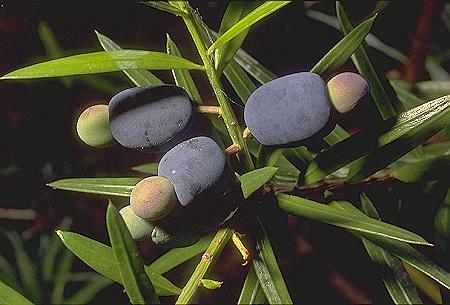
Podocarpus arils are edible. The seeds on the end are not. Photo by Green Deane
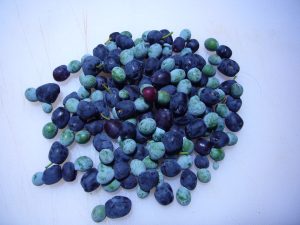
With their seeds removed the arils can be used like grapes. Photo by Green Deane
Podocarpus are not fickle but they are slightly unpredictable. The species is a common hedge plant, almost as common as the Yaupon Holly. And if not trimmed regularly will grow into a tall pine-like tree. The seeds are mildly toxic but the ripe arils are quite edible. Target date for ripeness is about August. However, last week in Sarasota we saw some ripe arils on some recently planted shrubs for landscaping. If you haven’t surmised by now we throw the seed (on the end) away and eat just the aril. A stem also goes through the arils and whether we eat that or not is a bit of a debate. I do, but only a few at a time and I’f full grown (if not a bit more.) A child eating a lot of aril stems might have a different experience so I tell kids to just eat the aril pulp. To read more about the Podocarpus go here. I have a video here.
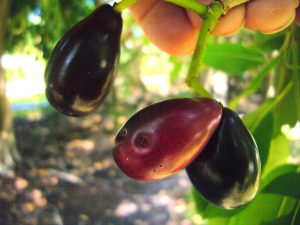
Even ripe Jambul fruit is slightly astringent. Photo by Green Deane
Mentioned earlier this year another species with an August target date for ripeness is the Java Plum or Jambul. Perhaps more sensitive to the weather or latitude one can find them fully ripe in July in some area of the state or not until September in others. By July I am checking the trees. Two weeks ago in West Palm Beach none were ripe, but some were in Port Charlotte. The one tree I know of mid-state is ripening enough now to drop some fruit. It is at the southwest corner of Aragon and Miles avenues, Winter Park. Look for the stained sidewalk. A year ago I started some Java Plum wine. The fruit is extremely astringent with tannins. Edible but not a lot at a time. A red wine is a good possibility. We’ll get to try it next year. To read more about the Java Plum go here.
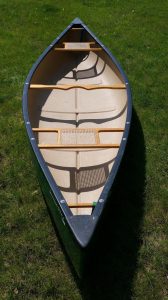
Twelve-foot Stillwater canoe by Old Town.
“Food is where the water is” is one of three bits of foraging advice I give in my classes as to where to find wild food. A boat is definitely not necessary but it can expand one’s opportunities. I have more watercraft than I have opportunities. How it is used is also a factor. Where I grew up canoes were rated by how much gear they could carry for staying in the wilderness… thus there were two-week canoes, a month canoe or two-month-ers. A classmate of mine is a Master Maine Guide (yep, there is a certification program and process.) I have an 88 pound 18-foot canoe that one could live out of. It’s the kind of canoe you use for a 300-mile downstream camping/fishing/foraging trip. Then I have a light 12-foot kayak for 30 mile trips upstream, some fishing almost no foraging. Tippy, one does wear an inflatable life vest. It fits in Van Go with the doors closed. My 12-foot pirogue is a Louisiana Jon Boat for small ponds, bayous, ox-bows (or billabongs as the Australian call them) and no current. With paddle or pole you can have it on the water in five minutes or less. The latest addition is a 56-pound 12-foot Stillwater canoe by Old Town from my native state of Maine. It’s for lazy rivers, large lake shores, some current, some paddling, no great distances. Wide and stable enough to stand in and fly cast, large enough for you, a big dog, and equipment… or two people if you’re good friends and can coordinate casts… and it fits in the van, doors closed… maybe there should be a canoe trailer in my future…
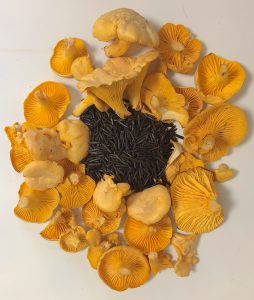
Wild Chanterelles and wild rice waiting to be cooked. Photo by Green Deane
There’s no joy in mushroomville, at least locally. I walked my Mushroom Mile yesterday and only saw toxic Amanitas. (One of the frustrating things about mushroom foraging is one can almost always find toxic mushrooms long before the edible ones.) Last year by this time we were collecting buckets of chanterelles. Two yeas ago that was a month off. Fungi growth in a given area depends on rainfall and ground temperatures. Both have to be right and we have not cross those criteria here in Central Florida. That said traffic on my five mushroom pages on Facebook is up dramatically. All tolled they have some 40,000 members including published authors and other exeprts. The most visited is Florida Mushroom Identification Forum. Frankly, I’d like to find someone to take them over. At least an hour every morning is spent approving posts, commenting, and deleting posts (if Facebook does not beat me to it. Most deleted posts and members stem from illegal drug sales.) As administrator I try to spread more light than heat but that’s difficult with willfully blind people.

Classes are held rain or shine or cold. (Hurricanes are an exception.) Photo by Kelly Fagan.
Foraging Classes. One class this holiday weekend, Saturday in Gainesville. We are also getting folks sighing up for foraging classes in South Carolina in mid-July. For that email me at GreenDeane@gmail.com or Putneyfarm@aol.com
Saturday July 3rd, Boulware Springs Park, 3420 SE 15th St., Gainesville, FL 32641. Meet at the picnic tables next to the pump house. 9 a.m. to noon.
Saturday July 10th, Ft. Desoto Park, 3500 Pinellas Bayway S. St. Petersburg Fl 33715. There is an entrance fee to the park. Meet at the fishing pier parking lot (which is also where you take the ferry.) It’s a large parking lot, meet near the bathrooms. 9 a.m. to noon.
Sunday July 11th, Mead Garden: 1500 S. Denning Dr., Winter Park, FL 32789. Meet at the bathrooms. 9 a.m. to noon. Entrance to the bark is on Denning. Some GPS get it wrong.
Saturday July 17th, Classes at 9 a.m. and 1 p.m at Putney Farm, 1624 Taylor Rd, Honea Path, SC 29654.
Sunday July 18th, Classes at 9 a.m. and 1 p.m at Putney Farm, 1624 Taylor Rd, Honea Path, SC 29654.
For more information, to prepay or sign up for a class go here.
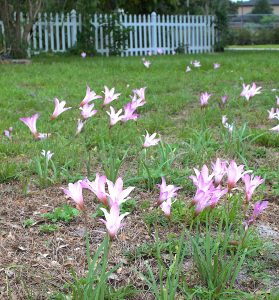
The Toxic Atamasco Lily, grows in the crescent south, Alabama to Virginia including central Florida north. Photo by Green Deane.
Four weeks ago we saw our first seasonal Atamoasco Lily. They are toxic and a treatened species (as they are not edible probably lost of habitat is threatening them.) The Atamasco Lily, aka Rain Lily ( Zephranthes atamasca) has been growing profusely on local lawns. These natives like wetlands but a well-watered lawn after seasonal rains will do nicely. The problem with the Atamasco is that it resembles wild garlic before it blossoms (and even has a bulb!) However, it does not have the telltale garlic aroma. Remember: If it smells like a garlic AND looks like a garlic you can use it like a garlic. The Atamasco does not have any garlic aroma. It is not edible. All parts are poisonous. And while these in the picture have a pink tinge there are also all-white blossoms. They will grow in shade. As the species is very bitter it would be difficult to eat though they can be fatal containing the alkaloid lycorine and others. Symptoms would be nausea, vomiting and diarhea usually within two hours. The most common source of lycorine poisoning is the consumption of daffodil bulbs.

Green Deane videos are now available on a USB.
My nine-DVD set of 135 videos has been phased out and replaced by a 150-video USB. The USB videos are the same videos I have on You Tube. Some people like to have their own copy. The USB videos have to be copied to your computer to play. If you want to order the USB go to the DVD/USB order button on the top right of this page. That will take you to an order form. I’d like to thank all of you who ordered the DVD set over the years which required me to burn over 5,000 DVDs individually.

Green Deane Forum
Want to identify a plant? Perhaps you’re looking for a foraging reference? You might have a UFO, an Unidentified Flowering Object, you want identified. On the Green Deane Forum we — including Green Deane and others from around the world — chat about foraging all year. And it’s not just about warm-weather plants or just North American flora. Many nations share common weeds so there’s a lot to talk. There’s also more than weeds. The reference section has information for foraging around the world. There are also articles on food preservation, and forgotten skills from making bows to fermenting food. 
Your donations to upgrade the EatTheWeeds website and fund a book were appreciated. A book manuscript has been turned it. It had 425 articles, 1326 plants and a third of a million words. What it will be when the publisher is done with it next year is unknown. It will be published in the spring of 2023. Writing it took a significant chunk of time out of my life from which I have still not recovered. (Many things got put off.) The next phase is to update all the content on the website between now and publication date. Also note as it states above the 135-video DVD set has been phased out for 150-video USB. Times and formats change. Which reminds me I need to revisit many plants and make some new videos.
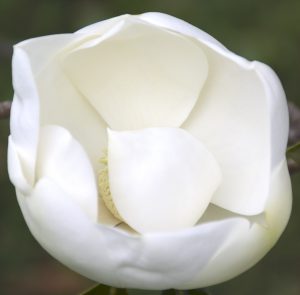
Magnolia grandiflora petals. Photo by Green Deane
Is it time to rethink Magnolias? The leaves of Magnolia grandiflora can be used like a bay leaf and the blossoms lacto-fermented into a condiment (quite popular in England.) M. grandiflora is not the best leaf in the wild for flavoring, however. That distinction goes to a relative, M. virginana, also known as the Sweet Bay. It’s among the easiest of trees to identify. As I have been making wine lately — see the article below — I pondered making a test gallon of Magnolia Blossom Mead… Magnolia scent and honey… It temps the senses nicely in theory but… The first point is mead. It’s made from honey and takes a long time to ferment. What materials you have in the mead stay in there for a long time. So, if you are going to add cinnamon you only need to add a little because it all gets extracted over time. I am making some Juniper Berry Mead now. Maybe it will be ready next year. Wine can be much different. If you make a fruit wine the fruit is in the “must” for about a week only. It’s an overlay flavor not the total focus. Wine is today, mead is tomorrow. With Magnolia Blossom Mead in mind I picked 580 grams of M. grandiflora blossoms. As I didn’t want them sitting in the mead for months or years I brought them to boil in a gallon of water then let them cool. The resulting tea was exceptionally bitter and vegetative tasting. Not the best candidate for mead or wine. Plan B: Magnolia Blossoms sparingly might be a good hops replacement in making beer and give a nice nose, too. The bitterness of the M. grandiflora raised another possibility: The Sweet Bay blossoms might be a better choice. That is Plan C. I’ll collect some of those blossom and give them a go.
This is weekly newsletter #463. If you want to subscribe to this free newsletter you can find the sign-up form in the menu at the top of the page.

